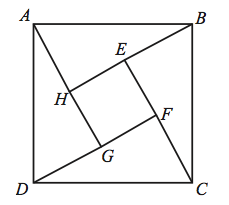Difference between revisions of "2005 AMC 10A Problems/Problem 8"
Dairyqueenxd (talk | contribs) (→Solution) |
|||
| (13 intermediate revisions by 9 users not shown) | |||
| Line 1: | Line 1: | ||
== Problem == | == Problem == | ||
| − | In the figure, the length of side <math>AB</math> of square <math>ABCD</math> is <math>\sqrt{50}</math> and <math>BE</math> | + | In the figure, the length of side <math>AB</math> of square <math>ABCD</math> is <math>\sqrt{50}</math> and <math>BE=1</math>. What is the area of the inner square <math>EFGH</math>? |
[[File:AMC102005Aq.png]] | [[File:AMC102005Aq.png]] | ||
| Line 7: | Line 7: | ||
==Solution== | ==Solution== | ||
| − | + | We see that side <math>BE</math>, which we know is <math>1</math>, is also the shorter leg of one of the four right triangles (which are congruent, I won’t prove this). So, <math>AH = 1</math>. Then <math>HB = HE + BE = HE + 1</math>, and <math>HE</math> is one of the sides of the square whose area we want to find. So: | |
| − | < | + | <cmath>1^2 + (HE+1)^2=\sqrt{50}^2</cmath> |
| − | < | + | <cmath>1 + (HE+1)^2=50</cmath> |
| − | < | + | <cmath>(HE+1)^2=49</cmath> |
| − | < | + | <cmath>HE+1=7</cmath> |
| − | < | + | <cmath>HE=6</cmath> |
| + | So, the area of the square is <math>6^2=\boxed{\textbf{(C) }36}</math> | ||
| − | ==See | + | ==See also== |
| + | {{AMC10 box|year=2005|ab=A|num-b=7|num-a=9}} | ||
| − | + | {{MAA Notice}} | |
| − | |||
Latest revision as of 10:58, 13 December 2021
Problem
In the figure, the length of side ![]() of square
of square ![]() is
is ![]() and
and ![]() . What is the area of the inner square
. What is the area of the inner square ![]() ?
?
![]()
Solution
We see that side ![]() , which we know is
, which we know is ![]() , is also the shorter leg of one of the four right triangles (which are congruent, I won’t prove this). So,
, is also the shorter leg of one of the four right triangles (which are congruent, I won’t prove this). So, ![]() . Then
. Then ![]() , and
, and ![]() is one of the sides of the square whose area we want to find. So:
is one of the sides of the square whose area we want to find. So:
![]()
![]()
![]()
![]()
![]() So, the area of the square is
So, the area of the square is ![]()
See also
| 2005 AMC 10A (Problems • Answer Key • Resources) | ||
| Preceded by Problem 7 |
Followed by Problem 9 | |
| 1 • 2 • 3 • 4 • 5 • 6 • 7 • 8 • 9 • 10 • 11 • 12 • 13 • 14 • 15 • 16 • 17 • 18 • 19 • 20 • 21 • 22 • 23 • 24 • 25 | ||
| All AMC 10 Problems and Solutions | ||
The problems on this page are copyrighted by the Mathematical Association of America's American Mathematics Competitions. 










